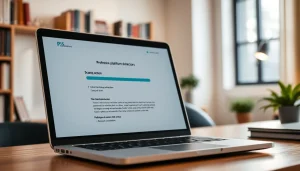Enhancing Academic Integrity: A Comprehensive Guide to the Plagiarism Detector
Understanding Plagiarism and Its Implications
Definition of Plagiarism
Plagiarism is the act of using someone else’s work, ideas, or intellectual property without proper acknowledgment, presenting it as one’s own. This can encompass written texts, graphics, music, and even digital content. The definition extends beyond mere copying; it includes paraphrasing without due credit and failing to cite sources accurately. Understanding plagiarism is fundamental, especially in academic and professional environments, where integrity and originality are paramount.
Types of Plagiarism
Plagiarism manifests in various forms, each with distinct characteristics. The most common types include:
- Direct Plagiarism: Copying text verbatim from a source without attribution.
- Self-Plagiarism: Reusing your previous work without mention, which is often an issue in academic settings.
- Patchwork Plagiarism: Mixing various sources without proper citations, maintaining the original phraseology.
- Accidental Plagiarism: Failing to cite sources or misquoting due to carelessness or lack of understanding.
Consequences of Plagiarism
The ramifications of engaging in plagiarism can be severe. Academically, it can lead to failing grades, suspension, or expulsion from educational institutions. Professionally, individuals may face job loss, legal actions, and irreparable harm to their reputations. Furthermore, plagiarism undermines the trust that forms the foundation of scholarly discourse and innovation. Thus, understanding the consequences reinforces the importance of using a plagiarism detector to uphold integrity in writing.
The Role of Plagiarism Detectors
How Plagiarism Detectors Work
Plagiarism detectors use advanced algorithms and databases to identify similarities between submitted texts and existing works. They typically function in several stages:
- Text Analysis: The detector scans the text for phrases and patterns, breaking down the content to analyze word choice and structure.
- Database Comparison: The tool compares the analyzed content against extensive databases of online publications, articles, and academic work.
- Report Generation: Once the scan is complete, a report is produced, detailing matches found, their sources, and the percentage of originality.
Benefits of Using a Plagiarism Detector
Utilizing plagiarism detection tools offers numerous benefits, including:
- Enhancing Academic Integrity: Ensures that students and researchers uphold ethical standards in their work.
- Improving Writing Quality: Helps writers identify areas that require proper citation or original writing.
- Saving Time: Streamlines the process of checking for unintentional plagiarism compared to manual checks.
Common Features in Plagiarism Detectors
Many reputable plagiarism detection tools share common features aimed at effectively identifying and managing plagiarism:
- Real-time Scanning: Allowing immediate feedback on documents as they are created.
- Comprehensive Databases: Access to extensive online publications, journals, and educational resources.
- Diverse Format Support: Capability to check various file formats, such as DOCX, PDF, and HTML.
- Detailed Reports: Providing insights into the level of plagiarism detected, including sources and similarity percentages.
Choosing the Right Plagiarism Detector
Key Considerations for Selection
Selecting a plagiarism detector is a critical decision, influenced by several factors:
- Accuracy: Look for tools that use robust algorithms and extensive databases for reliable results.
- User Interface: A simple and intuitive interface enhances user experience.
- Cost: While some tools offer free services, others require subscriptions or one-time payments. Consider your budget and the scope of your needs.
- Customer Support: Ensure there is reliable support available for troubleshooting and assistance.
Comparative Analysis of Popular Tools
Multiple plagiarism detection tools are available, each with unique features and strengths. Here’s a comparative analysis of some popular options:
| Tool Name | Key Features | Pricing |
|---|---|---|
| Plagiarism Detector | Free, accurate, and one-click checking | Free |
| Grammarly | AI-integrated checker, grammar checking | Freemium |
| DupliChecker | 100% free, simple copy-paste functionality | Free |
| Scribbr | Accurate checks, particularly for modified texts | Paid |
| PapersOwl | AI-powered, all common formats | Free |
User Reviews and Feedback
User reviews of plagiarism detectors offer vital insights into their usability and effectiveness. Checking feedback on forums, review sites, and direct user testimonials helps gauge satisfaction levels:
- Positive Feedback: Many users highlight the accuracy and efficiency of tools like Grammarly and Scribbr, praising their user-friendly interfaces.
- Constructive Criticism: Some users express concerns regarding the pricing structure of premium features in certain detectors. Others mention that free tools may lack comprehensiveness.
Best Practices for Using a Plagiarism Detector
How to Effectively Check Documents
To maximize the benefits of a plagiarism detector, consider the following best practices regarding document checks:
- Prepare Your Document: Ensure that your text is finalized before checking for plagiarism to prevent unnecessary revisions.
- Utilize Multiple Tools: Don’t rely solely on one detector; use several tools for comprehensive results.
- Regular Checks: Implement routine checks for ongoing projects to prevent unintentional plagiarism.
Interpreting Plagiarism Reports
Understanding the results from plagiarism detection reports is crucial. A few tips include:
- Look for Percentage Scores: Higher percentages indicate more significant overlaps; aim for lower scores in original work.
- Analyze Source Matches: Review the provided sources to determine if proper citation can be added or if rephrasing is needed.
- Understand Context: Not all matches may be considered plagiarism depending on their context; quotes, common knowledge, and facts may not require citation.
Integrating Results into Your Writing Process
Effective integration of plagiarism detection results can significantly improve written work:
- Revise and Edit: Use the feedback to revise and enhance originality in your document.
- Cite Sources: Incorporate citations for any borrowed ideas to maintain academic integrity.
- Develop Your Style: Learn from patterns identified in your reports to create more original content in future writing endeavors.
Future Trends in Plagiarism Detection Technology
Advancements in AI and Machine Learning
As technology evolves, so too do plagiarism detection tools. The integration of AI and machine learning enhances these tools significantly:
- Increased Accuracy: AI algorithms can learn from vast datasets, improving accuracy in detecting nuanced similarities.
- Contextual Understanding: Future tools may better understand the context of writing, distinguishing between paraphrasing and legitimate originality.
The Broader Impact on Education and Content Creation
Improved plagiarism detection technology fosters a culture of integrity and scholarship. Educational institutions are likely to:
- Implement Preventative Measures: By educating students about plagiarism and emphasizing the use of detection tools.
- Enhance Learning: Encouraging original thought processes rather than rote learning to prepare students for future challenges.
Ethical Considerations in Plagiarism Detection
With advancements come ethical considerations that need addressing:
- Privacy Issues: Ensuring that submitted texts are not stored and misused without the author’s consent.
- Overreliance on Technology: Encouraging a balanced approach towards plagiarism detection and manual comprehension of originality.



